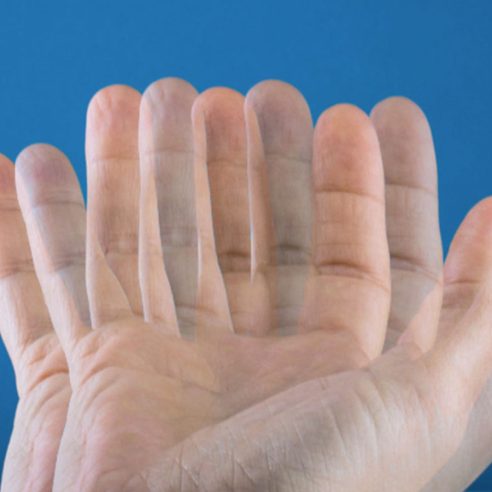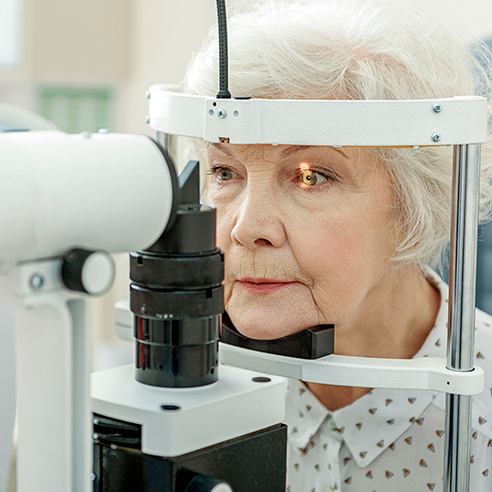Headache of ocular origin: symptoms and diagnosis
Acute headaches are known in specialist medicine as “headaches”. Sometimes headaches are caused by fatigue, stress, intense physical effort, hunger or menstruation. Other times, headaches have to do with taking certain medications, such as oral contraceptives, or eating foods containing tyramine, nitrates or monosodium glutamate (e.g. blue cheeses, yoghurts, ice cream, cold cuts or chicken liver). Alcohol and caffeine are other substances that can cause headaches. But these are all temporary and once the cause is addressed, the migraine passes. If the pain is severe, a headache is a sign of a more serious illness, in which case a specialist consultation is a must.
One of the most common types of headache is headache of ocular origin. It occurs as a result of an ophthalmological disorder.
How many types of headache are there?
Headache occurs when overactive nerve cells send impulses to the brain. Blood vessels then dilate and release inflammatory substances, which trigger throbbing pain. The headache can be:
- Primary
- Migraines
- Tension-type headache, also known as stress headache, idiopathic headache or psychogenic headache
- Cluster headache, also known as migrainous or ciliary neuralgia, cephalgia, Horton’s syndrome or cluster headache
- Chronic headache
- Chronic progressive headache, also known as inflammatory headache
- Occipital headache
- Secondary (caused by diseases of neighboring organs, nervous diseases and mental illness)
Headache of ocular origin is a secondary headache caused by a disorder in the eye. Glaucoma, vision impairments and strabismus are among the most common causes of headache of ocular origin.
What causes the headache of ocular origin?
- Headaches of ocular origin are most common in patients who experience refractive errors and do nothing to correct them. Hypermetropia, myopia and astigmatism are ophthalmic diseases that affect near, far or both near and far vision, depending on the type of disorder and how advanced it is. Headache usually occurs after long periods spent in front of the TV, computer or telephone, or after the patient writes or reads a lot. In this case, the headache of ocular origin is supraorbital and may radiate to the temporal and occipital regions.
- Supraorbital headache is also when the patient suffers from a cornea, iris or ciliary body disorder. These are visible by redness of the eyes and sensitivity to light. Headache is common here because the iris, ciliary body and cornea are highly sensory innervated.
- Strabismus is another ophthalmological disorder that can manifest itself in headaches. “Crossed vision” or “crossed-eye gaze” is a disorder where binocular vision is impaired and one eye deviates when it needs to look at a fixed point.
- Glaucoma can also cause headaches. In addition to headaches, the patient also experiences: eye pain, tunnel vision, sensitivity to light, red eyes, nausea, vomiting and blurred vision.
What are the symptoms of headache?
Signs of headache of ocular origin are:
- Eye pain
- Sensitivity to light
- Vision impairment
- Dizziness
- Feeling nauseous
- Vomiting
- High blood pressure
- Fever
- Seizures
- Palsy
How is headache of ocular origin diagnosed?
Diagnosis is made during an ophthalmological examination. This involves a series of detailed investigations:
- Determine the patient’s history (how common headaches are, when they occur, how severe they are, what factors trigger them, whether there is a family history of headaches)
- Establishing visual acuity
- Measurement of ocular refraction
- Measurement of intraocular pressure
- Ocular motility examination
- Anterior pole biomicroscopy
- Fundus examination
- Computerized perimetry
- Gonioscopy
- If, in addition to headaches, the patient also presents loss of consciousness, an electroencephalogram is recommended.
- Other investigations: CT scan, MRI, lumbar puncture – depending on the specialist’s observations.
Headache in children
Headache in children is often associated with colds and infections of the sinuses, ears or throat. Other causes:
- Dehydration
- Ophthalmological diseases
- Dental diseases
- Lack of restful sleep
- Too much screen time
- Meningitis
- Head trauma
- Brain tumors
Contact the emergency doctor if you notice children who are complaining of:
- Any headache, if they are under 4 years of age
- Headache right when they wake up from sleep
- Headaches that become increasingly frequent or intense
- Headache, fever, vomiting and nausea
- Headaches accompanied by blurred vision
- Headache after fall or a hit
- Headache accompanied by loss of consciousness
Headache: Ophthalmologic treatment
In the case of headache of ocular origin, the ophthalmological examination will also determine the type of treatment. Depending on the severity of the disorder, the patient may be prescribed the following:
- Prescription glasses or contact lenses
- Topical treatment based on eye drops
- Medication (analgesics, anti-inflammatories, vasoconstrictors)
- Laser eye surgery
Dr. Holhoș clinics are equipped with state-of-the-art equipment and technology in the ophthalmology industry. These, in the hands of the specialists within the Dr. Holhoș network, will improve not only the quality of your vision, but also the quality of your life.
Text medically reviewed by Dr. Teodor Holhoș, Ophthalmic Surgeon
Written by
Dr. Holhos Team Diseases
Nystagmus is the eye condition where the eyes make repetitive and uncontrollable movements. Discover other symptoms and treatment options.
Color vision deficiency, also known as dyschromatopsia, is a general term referring to various vision disorders characterized by a deficiency in color perception.
“Flying flies” are most often harmless and represent a normal stage in the aging process. Find out what the causes are and how you can reduce the symptoms.
Ocular allergies occur as a reaction of the body to an allergen, causing inflammation and itching in the eyes. The most common ocular allergies are seasonal.
Ophthalmic migraine is most common in the 40s. It manifests itself in visual impairment and even temporary blindness.
Keratitis, also known as “corneal ulcer”, is an inflammation of the cornea. If detected early, the ophthalmological disorder is easy to treat and heals quickly.
Diplopia is an ophthalmological disease in which you see two images of the same thing. The condition can affect anyone, but is more common after the age of 60.
Xanthelasma is a member of the xanthomas family and represents fatty deposits in the skin cells around the eyes. It is visible as yellow, harmless bumps.
Colorblind people perceive colors differently from most people. Most of the time, this ophthalmological disorder makes it difficult to distinguish between certain colors.
Epiphora is an ophthalmological disorder manifested by excessive tearing of the eyes. Most of the time, it is not severe and disappears on its own. However, if you are experiencing this and the problem persists, we recommend that you make an appointment for an ophthalmological examination. Treatment can be different, depending on the cause of the epiphora.
If you notice a yellow spot on the white of your eye, you are most likely dealing with pinguecula. The ophthalmological disorder is not severe, but the symptoms can be uncomfortable. Find out how to treat pinguecula and, more importantly, how you can prevent it.
Entropion is the ophthalmological disorder in which the eyelid of the eye turns inwards. It is different from ectropion, where the eyelid turns outwards. It most often occurs in older people and usually only affects the lower eyelid.
It is possible that you may also be experiencing ocular toxoplasmosis without knowing it. This retinal disorder is extremely common in our century and is manifested by eye discomfort and blurred vision.
Ectropion is the ophthalmic disorder in which the eyelid and eyelashes pull away from the cornea, and reorient outwards.
One of the most common types of headache is headache of ocular origin. It occurs as a result of an ophthalmological disorder.
Blepharitis is an ophthalmological disorder that manifests itself by inflammation of the eyelids. At the base of the eyelids, the patient notices small crusts formed by solidified oil particles or bacteria that collect in the crease at the corner of the eye.
Uveitis is an ophthalmological disorder of the uveal tract, manifested by changes in vision and eye pain.
Among the most common ophthalmological disorders is hordeolum. This is popularly known as an “stye” and is an infection of the eyelids.
The drooping eyelid is known in medical terms as “palpebral ptosis”. It manifests itself by narrowing the visual slit of one or both eyes, creating aesthetic and functional discomfort.
Amblyopia is a vision problem, popularly known as “lazy eye”. This disorder can occur in one or both eyes, and studies show that around 3% of the population suffer from this eye disease.
The sensation of “dry eyes” or “tired eyes” is known in medical terms as “dry keratoconjunctivitis” or “xerophthalmia”, and refers to a dysfunction of the tear film.
Strabismus, also known as “crossed-eyes” or “crossed vision”, is an ophthalmological disorder in which the visual axis of the eyes is not aligned. This causes one eye to deviate when it needs to look at a fixed point.
Conjunctivitis is one of the most common ophthalmological disorders. It can occur in adults, children and babies.
Chalazion is manifested by inflammation of the upper or lower eyelid. It is one of the most common ophthalmological disorders, and occurs when the secretion of sebaceous glands in the eye is blocked.
Macular degeneration involves deterioration of the macula and therefore of the quality of central vision. This disease does not affect peripheral vision and therefore cannot lead to complete blindness.
Hypermetropia affects the ability to see nearby objects. You may be able to see distant objects clearly, but closer objects, even words in a book, are usually out of focus. Hypermetropia occurs when the eye does not focus light properly on the retina (the light-sensitive layer at the back of the eye).
Myopia is a disorder that falls into the category of refractive errors (along with astigmatism and hypermetropia). In common terms, myopia manifests itself as blurred distance vision, while near vision is not a problem.
Astigmatism, like myopia and hypermetropia, is a refractive error. In general terms, the disorder manifests itself in blurred, fuzzy vision, regardless of the distance to objects, surfaces.
Presbyopia is an age-related disorder characterized by decreased near vision. It usually appears around the age of 40.
Cataract is a common ophthalmological disorder that causes progressive loss of vision through loss of lens transparency. Studies show that about 50% of the population loses their vision due to this disorder.
Cataract is a fairly common eye disorder that causes a progressive loss of vision due to loss of lens transparency.
Diabetic retinopathy is a complication of diabetes that manifests itself at the eyes level, caused by high blood sugar levels and damage to the blood vessels of the light-sensitive tissue at the back of the eye (retina).
The retina is the light-sensitive layer deep inside the eyeball, lining the back of the eye. It is a piece of neural tissue that creates a focused two-dimensional image that is translated into a neural electrical impulse that translates the image to create visual perception.
Epiretinal membrane is a disorder of the interface area between the posterior vitreous and the central area of the retina, the macula.
The vitreous body is located in the center of the eyeball, between the lens and the retina, and appears as a “gel”. A healthy vitreous is completely transparent allowing light to reach the retina without any problems, thus obtaining a clear vision.
Glaucoma is a chronic, bilateral eye disease characterized by progressive destruction of the fibers of the optic nerve, the nerve responsible for transmitting information from the eye to the brain.
Keratoconus is a degenerative disease that manifests itself by progressive deformation and thinning of the cornea. It usually appears in adolescence, affects both men and women, and progresses into adulthood.






































